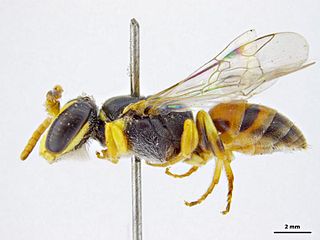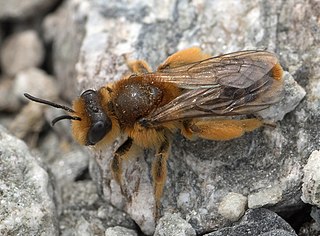
The term cuckoo bee is used for a variety of different bee lineages which have evolved the kleptoparasitic behaviour of laying their eggs in the nests of other bees, reminiscent of the behavior of cuckoo birds. The name is perhaps best applied to the apid subfamily Nomadinae, but is commonly used in Europe to mean bumblebees Bombus subgenus Psithyrus. Females of cuckoo bees are easy to recognize in almost all cases, as they lack pollen-collecting structures and do not construct their own nests. They often have reduced body hair, abnormally thick and/or heavily sculptured exoskeleton, and saber-like mandibles, although this is not universally true; other less visible changes are also common.

The Colletidae are a family of bees, and are often referred to collectively as plasterer bees or polyester bees, due to the method of smoothing the walls of their nest cells with secretions applied with their mouthparts; these secretions dry into a cellophane-like lining. The five subfamilies, 54 genera, and over 2000 species are all evidently solitary, though many nest in aggregations. Two of the subfamilies, Euryglossinae and Hylaeinae, lack the external pollen-carrying apparatus that otherwise characterizes most bees, and instead carry the pollen in their crops. These groups, and most genera in this family, have liquid or semiliquid pollen masses on which the larvae develop.

Hylaeus is a large and diverse cosmopolitan genus within the bee family Colletidae. This genus is also known as the yellow-faced bees or masked bees. This genus is the only truly globally distributed colletid, occurring on all continents except Antarctica.

The Stenotritidae is the smallest of all formally recognised bee families, with only 21 species in two genera, all of them restricted to Australia. Historically, they were generally considered to belong in the family Colletidae, but the stenotritids are presently considered their sister taxon, and deserving of family status. Of prime importance is that the stenotritids have unmodified mouthparts, whereas colletids are separated from all other bees by having bilobed glossae.

Hylaeus alcyoneus, commonly known as the banksia bee, is a bee species endemic to Australia where it is commonly found in the coastal heaths of eastern and southern Western Australia. This bee is an important pollinator of Banksia species.
Verticordia aurea, commonly known as buttercups is a flowering plant in the myrtle family, Myrtaceae and is endemic to the south-west of Western Australia. It is a slender, sometimes bushy shrub with a single stem at the base, cylindrical leaves and heads of scented, golden-yellow flowers in spring.

The Labeninae is a subfamily within the parasitic wasp family Ichneumonidae . There are 12 extant genera, grouped within four tribes, that exhibit a predominantly Gondwanan distribution - most genera and species are found in Australia and South America. A few species of Labena and Grotea are found in North America, with hypotheses suggesting that the group radiated on Gondwanaland prior to the separation of Australia but after the separation of Africa/India/Madagascar.
Lipara is a genus of flies in the family Chloropidae. Among the Palearctic species, a specific community of bees and wasps make their nests in the galls of chloropid flies. Most frequently, they use the galls induced by Lipara lucens on common reed stems. Some of these aculeate hymenopteran species, such as the digger wasp Pemphredon fabricii (Crabronidae) or the solitary bee Hylaeus pectoralis (Colletidae) are specialized for nesting in galls induced by Lipara spp. more than a year ago.

Hylaeus sanguinipictus is a bee species endemic to Western Australia. It was described in 1914 from material collected in Yallingup by Theodore Dru Alison Cockerell as Prosopis sanguinipicta.

Leioproctus fulvescens is a species of solitary bee belonging to the family Colletidae. This bee is endemic to the South Island of New Zealand, and its yellow-orange hair distinguishes it from all other New Zealand species of Leioproctus.
Josephine Christina Cardale worked as an entomologist for CSIRO from 1967 to 2001. She was a collection manager of Hymenoptera at the Australian National Insect Collection.

Hylaeus agilis is a bee species in the family Colletidae. It is endemic to New Zealand. This species is found throughout the country and visits the flowers of a wide variety of plant species, both native and introduced.

Hylaeus hyalinatus is a species of hymenopteran in the family Colletidae. It can be found in Europe, including Great Britain. It is an invasive species in North America.

Hylaeus relegatus is a bee species in the family Colletidae. It is endemic to New Zealand and was first described by Frederick Smith. It is the largest and most common species of this genus in that country. H. relegatus can be found throughout the three main islands of New Zealand and visits the flowers of a wide variety of plant species, both native and introduced. Although widespread, this species is not abundant at any one particular location. It has been hypothesised that human made nest sites can be used to increase its numbers.

Hylaeus euxanthus is a species of hymenopteran in the family Colletidae and the subgenus Gnathoprosopis. It is found in Australia.

Hylaeus azorae is a species of bee in the family Colletidae. It is known only from the island of Pico in the Azores.

Hylaeus nubilosus is a species of insect within the genus Hylaeus. It is commonly referred to as the cloudy masked bee.

Hylaeus lactiferus, also known as Pharohylaeus lactiferus or the cloaked bee, is a rare species of bee native to tropical and subtropical forests in northeast Australia. The species is an example of a Lazarus taxon, with no reliable records published between 1923 and its rediscovery in 2008.

Hylaeus nigritus, also known as the black masked bee, is a species of solitary bee native to much of Europe, with sightings and preserved specimens recorded as far east as Nizhny Novgorod, Russia and the Caucuses.
Hylaeus perkinsianus, commonly known as Perkin's yellow-faced bee, is a species of yellow-faced bee in the family Colletidae. It was described by Philip Hunter Timberlake in 1926, and named for Robert Cyril Layton Perkins. The species is entirely endemic to the island of Nihoa, Hawaiian Islands, where its range covers a majority of the island. It is listed by the Center for Biological Diversity as Declining and Threatened.
















